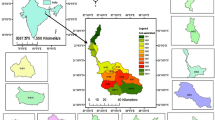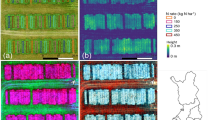Abstract
Estimation of reservoir water-spread area is often carried out by field surveys which are cumbersome, time consuming, expensive and involves more man power. Hence, such surveys cannot be carried out periodically. To overcome this issue, satellite images are used, wherein the reservoir water-spread is estimated by conventional per-pixel classification such as the maximum likelihood and minimum distance to mean approaches that often results in inaccurate estimate of water-spread area due to the presence of mixed pixels. High cost and non-availability of high resolution images demands the use of an alternative approach that can give accurate information about the reservoir water-spread area. In this work, IRS, LISS III images of moderate (24 m) resolution were used for accurate estimation of the water-spread area of Singoor reservoir, southern India. The reservoir water-spread areas were extracted using per-pixel classification, sub-pixel classification and super resolution mapping approaches. These results were validated with the water-spread areas obtained from field data of the same dates. The error produced by the per-pixel approach was 6.66%, while it was 4.37% for the sub-pixel approach and a meagre 1.71% for the super-resolution approach. Fairly less error produced by the super resolution mapping technique implies that it is an efficient approach for accurate quantification of reservoir water-spread area. The estimated water-spread can be used in a simple volume estimation formula to estimate the capacity of the reservoir.






Similar content being viewed by others
References
Aplin, P., & Atkinson, P. M. (2001). Sub-pixel land cover mapping for per-field classification. International Journal of Remote Sensing, 22(14), 2853–2858.
Atkinson, P. M. (1997). Mapping sub-pixel boundaries from remotely sensed images. In Z. Kemp (Ed.), Innovations in GIS IV (pp. 166–180). London: Taylor and Francis.
Atkinson, P. M. (2008). Super-resolution mapping using the two-point histogram and multi-source imagery. In A. Soares, M. J. Pereira, & R. Dimitrakopoulos (Eds.), geoENV VI—Geostatistics for Environmental Applications (pp. 307–321). Netherlands: Springer.
Bastin, L. (1997). Comparison of fuzzy c-means classification, linear mixture modelling and MLC probabilities as tools for unmixing coarse pixels. International Journal of Remote Sensing, 18(17), 3629–3648.
Eismann, M. T., & Hardie, R. C. (2005). Hyperspectral resolution enhancement using high-resolution multispectral imagery with arbitrary response functions. IEEE Transactions on Geoscience and Remote Sensing, 43(3), 455–465.
Foody, G. M. (1996). Approaches for the production and evaluation of fuzzy land cover classifications from remotely sensed data. International Journal of Remote Sensing, 17(7), 1317–1340.
Foody, G. M., & Cox, D. P. (1994). Sub-pixel land cover composition estimation using a linear mixture model and fuzzy membership functions. International Journal of Remote Sensing, 15(3), 619–631.
Foody, G. M., Muslim, A. M., & Atkinson, P. M. (2005). Super-resolution mapping of the waterline from remotely sensed data. International Journal of Remote Sensing, 26(24), 5381–5392.
Goel, M. K., Jain, S. K., & Agarwal, P. K. (2002). Assessment of sediment deposition rate in Bargi reservoir using digital image processing. Journal of Hydrological Sciences, 47(S), S81–S92.
Heller, R. C., & Johnson, K. A. (1979). Estimating irrigated land acreage from Landsat imagery. Photogrammetric Engineering and Remote Sensing, 57, 119–126.
Heltin, G. C., & Vani, K. (2010). Super resolution mapping of satellite images using Hopfield neural networks. In IEEE Conference on RSTSCC (pp. 114–118).
Holland, J., & Aplin, P. (2013). Super-resolution image analysis as a means of monitoring bracken (Pteridium aquilinum) distributions. ISPRS Journal of Photogrammetry and Remote Sensing, 75, 48–63.
Hung, M. C., & Wu, Y. H. (2005). Mapping and visualizing the Great Salt lake landscape dynamics using multi-temporal satellite images 1992–1996. International Journal of Remote Sensing, 26(9), 1815–1834.
Jensen, R. J. (1996). Introductory Digital Image Processing: A remote sensing perspective. London: Prentice Hall International Ltd.
Jensen, J. R., & Cowen, D. C. (1999). Remote sensing of urban/suburban infrastructure and socio-economic attributes. Photogrammetric Engineering and Remote Sensing, 65, 611–622.
Jeyakanthan, V. S., & Sanjeevi, S. (2011). Reservoir capacity estimation of Singoor reservoir, India, by per-pixel and sub-pixel processing of multi-date satellite images. Geocarto International, 26(4), 305–320.
Keene, K. M., & Conley, C. D. (1980). Measurement of irrigated acreage in Western Kansas from LANDSAT images. Environmental Geology, Earth and Environmental Science, 3(2), 107–116.
Lamyaa, G. E. T., & Salwa, F. E. (2010). Investigation of fusion of SAR and Landsat data for shoreline super resolution mapping: the northeastern Mediterranean Sea coast in Egypt. Applied Geomatics, 2, 177–186.
Lunetta, R., & Barlogh, M. (1999). Application of multispectral landsat 5 TM imagery for wetland identification. Photogrammetric Engineering and Remote Sensing, 45, 1379–1386.
Magendran, T., & Sanjeevi, S. (2014). Hyperion image analysis and linear spectral unmixing to evaluate the grades of iron ores in parts of Noamundi, Eastern India. International Journal of Applied Earth Observation and Geoinformation, 26, 413–426.
Manavalan, P., Sathyanath, P., & Rajegowda, G. L. (1993). Digital image analysis technique to estimate water-spread for capacity evaluations of reservoirs. Photogrammetric Engineering and Remote Sensing, 59(9), 1389–1395.
Mas, J. F. (1999). Monitoring land-cover changes: a comparison of change detection techniques. International Journal of Remote Sensing, 20, 139–152.
Mertens, K. C., Verbeke, L. P. C., Ducheyne, E. I., & De Wulf, R. R. (2003). Using genetic algorithm in subpixel mapping. International Journal of Remote Sensing, 24(21), 42441–44244.
Muad, A. M., & Foody, G. M. (2012). Super-resolution mapping of lakes from imagery with a coarse spatial and fine temporal resolution. International Journal of Applied Earth Observation and Geoinformation, 15, 79–91.
Muslim A. M., Razman, N., Khalil, I., Zain, K., & Ismail, K. I. (2011). Evaluation of soft classification algorithm for sub-pixel mapping of the shoreline. In ISPRS Proceedings (p. 34).
Nguyen, M. Q., Atkinson, P. M., & Lewis, H. G. (2006). Super-resolution mapping using a Hopfield neural network with fused images. IEEE Transactions on Geoscience and Remote Sensing, 44(3), 736–749.
NRSA (National Remote Sensing Agency) Data Center (2004). IRS-P6 data user’s handbook. Report No. IRS-P/NRSA/NDC/HB-01/04, pp. 22–24.
Oleson, K. W., Sarlin, S., Garrison, J., Smith, S., Privette, L., & Emery, W. (1994). Unmixing multiple land cover type reflectances from coarse resolution satellite data. Remote Sensing of Environment, 54(2), 98–112.
Peng, D., Guo, S., Liu, P., & Liu, T. (2006). Reservoir storage curve estimation based on remote sensing data. Journal of Hydrologic Engineering, 11(2), 165–172.
Ramsey, E. W., & Laine, S. C. (1997). Comparison of Landsat Thematic Mapper and high resolution photography to identify change in complex coastal wetlands. Journal of Coastal Research, 13, 281–292.
Ridd, M. K. (1995). Exploring a V-I-S (Vegetation-impervious surface-soil) model for urban ecosystem analysis through remote sensing-comparative anatomy for cities. International Journal of Remote Sensing, 16(2), 2165–2185.
Sanjeevi, S. (2008). Targeting limestone and bauxite deposits in Southern India by spectral unmixing of hyperspectral image data. The International Archives of the Photogrammetry, Remote Sensing and Spatial Information Sciences, 37(B8), 1189–1194.
Schowengerdt, R. A. (1997). Remote sensing models and methods for image processing. USA: Elsevier.
Settle, J. J., & Drake, N. A. (1993). Linear mixing and the estimation of ground cover proportions. International Journal of Remote Sensing, 14, 1159–1177.
Shalan, M. A., Arora, M. K., & Ghosh, S. K. (2003). An evaluation of fuzzy classifications from IRS 1C LISS III data. International Journal of Remote Sensing, 23(15), 3179–3186.
Tatem, A. J., Lewis, H. G., Atkinson, P. M., & Nixon, M. S. (2002). Super-resolution landcover pattern prediction using a Hopfield neural network. Remote Sensing of Environment, 9, 1–14.
Van der Meer, F. (1995). Spectral unmixing of Landsat Thematic Mapper data. International Journal of Remote Sensing, 16(16), 3189–3194.
Yuan, D., & Elvidge, C. (1998). NALC land cover change detection pilot study: Washington DC area experiments. Remote Sensing of Environment, 6, 166–178.
Zhang, J., & Foody, G. M. (2001). Fully–Fuzzy supervised classification of sub-urban land cover from remotely sensed imagery: Statistical and artificial neural network approaches. International Journal of Remote Sensing, 22(4), 615–628.
Acknowledgement
The authors thank the National Remote Sensing Centre (NRSC), Hyderabad, India for the IRS-P6 LISS III and IRS-1C PAN image data. The authors sincerely thank the anonymous reviewers and the editor-in-chief (Journal of Indian Society of Remote Sensing) for their comments and suggestions, which helped to refine this article.
Author information
Authors and Affiliations
Corresponding author
About this article
Cite this article
Shanmuga Priyaa, S., Jeyakanthan, V.S., Heltin Genitha, C. et al. Estimation of Water-Spread Area of Singoor Reservoir, Southern India by Super Resolution Mapping of Multispectral Satellite Images. J Indian Soc Remote Sens 46, 121–130 (2018). https://doi.org/10.1007/s12524-017-0666-x
Received:
Accepted:
Published:
Issue Date:
DOI: https://doi.org/10.1007/s12524-017-0666-x




